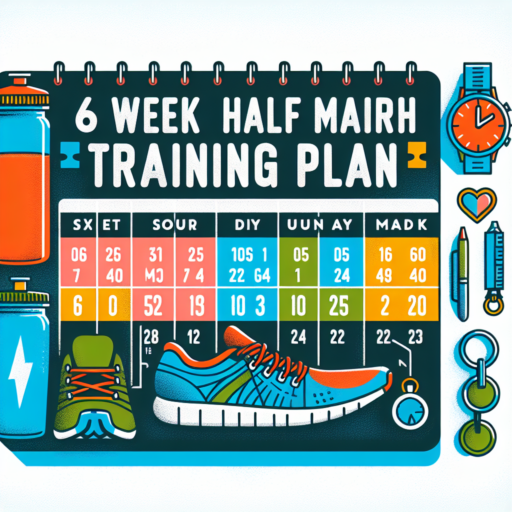What is a 1:45 Half Marathon Plan and Who is it For?
A 1:45 half marathon plan is a highly structured running schedule aiming for runners to complete a half marathon (13.1 miles or about 21.1 kilometers) in one hour and forty-five minutes. Such a program usually includes a mix of long runs, speed workouts, tempo runs, and recovery days, tailored to progressively build the runner’s endurance, speed, and running economy. This target time is quite competitive and suggests that the plan is designed for intermediate to advanced runners who have a solid foundation in running and are looking to push their limits and set a new personal record.
This specific plan is most suitable for runners who have previously completed a half marathon in times ranging from 1:50 to 2:00 hours and are looking to improve. It’s also ideal for those who can comfortably run longer distances at a pace that aligns with finishing a half marathon in 1:45. Typically, to follow such a schedule effectively, runners should already be running consistently for several months, covering weekly distances of at least 20-25 miles (approximately 32-40 kilometers).
The 1:45 half marathon plan requires dedication, discipline, and a certain level of physical fitness. It involves targeted workouts aimed at enhancing aerobic capacity, increasing speed, and boosting endurance. Runners embarking on this plan should be prepared to dedicate around 12-16 weeks of training, with varying intensities and distances throughout the week, peaking with a long run that gradually increases to 10-12 miles (16-19 kilometers) at a pace indicative of the 1:45 finish goal. Success with this plan not only hinges on physical preparedness but also mental readiness to tackle the challenges of higher-mileage weeks and more intense speed sessions.
The Essential Components of a Successful 1:45 Half Marathon Training Plan
Preparing for a 1:45 half marathon requires a well-structured training plan that encompasses various essential components. This goal is ambitious but achievable with dedication, proper planning, and understanding of the key elements that contribute to a successful half marathon performance. Each component of the training program plays a critical role in enhancing your running abilities and endurance, preparing you mentally and physically for the race day.
Structured Interval Training
Structured interval training is crucial for improving your race pace and overall running economy. These sessions involve running shorter distances at a faster pace than your target half marathon pace, followed by periods of low-intensity recovery. This type of training helps in increasing your lactate threshold, allowing you to maintain a faster pace for longer durations without fatigue setting in. Incorporating one to two interval sessions per week is a key strategy for developing the speed and stamina needed to complete a half marathon in under 1 hour and 45 minutes.
Long Distance Runs
To succeed in a 1:45 half marathon, long distance runs are non-negotiable. These runs, typically completed once a week, gradually increase in length, peaking at 10-12 miles before the tapering period. The primary aim is to build endurance and familiarize your body with prolonged periods of running. It’s essential to perform these runs at a comfortable pace, focusing on distance rather than speed, to enhance your aerobic capacity and mental resilience.
Proper Rest and Recovery
While rigorous training is fundamental, rest and recovery are equally important and should be an integral part of your training plan. Adequate sleep, nutrition, and hydration, along with rest days, play a significant role in preventing injuries and ensuring your body is well-prepared for the next training session. Incorporating active recovery days, such as light jogging or cycling, can also aid in muscle recovery and reduce fatigue. Remember, allowing your body to rest is key to achieving peak performance on race day.
Week-by-Week Breakdown: Your 1:45 Half Marathon Schedule
Embarking on the journey to achieve a half marathon time of 1:45 is an ambitious goal that requires a meticulously crafted plan and unwavering dedication. This target time translates to an average pace of approximately 8 minutes per mile, a feat that is attainable with the right preparation. Below is a week-by-week breakdown designed to guide you through each phase of your training, ensuring you are not only prepared to meet your goal but also to do so with confidence and strength.
Building a Solid Foundation
In the initial weeks, the focus is on building a solid aerobic base. This period involves consistent, easy-paced runs that gradually increase in duration. The aim is not yet on speed but rather on endurance, ensuring your body adapizes to the demands of prolonged running. During these weeks, incorporating cross-training activities like cycling or swimming can aid in building cardiovascular strength without the added impact on your joints.
Increasing Speed and Endurance
As you transition into the middle weeks of your training, emphasis shifts towards blending speed work with your established endurance base. Introducing interval training, tempo runs, and the occasional hill workout will not only improve your speed but also enhance your aerobic capacity. This phase is crucial for conditioning your body to sustain a faster pace over the duration of the half marathon.
Tapering and Recovery
The final weeks before race day are centred around tapering and recovery, ensuring your body is well-rested and primed for performance. It’s time to reduce the volume and intensity of your workouts, allowing your muscles to recover and strengthen. Emphasize rest, proper nutrition, and hydration as key components of your pre-race preparation. At this stage, confidence in your training and mental preparedness become as important as your physical condition.
Nutritional Strategies to Fuel Your 1:45 Half Marathon Goals
Successfully achieving a half marathon time of 1:45 requires not only rigorous training but also a meticulously planned nutritional strategy. To ensure your body has the energy and resilience needed, focusing on what and when you eat around this goal becomes crucial. Understanding the balance between carbohydrates, proteins, and fats, along with proper hydration, can set a powerful foundation for reaching and surpassing your goals.
Carbohydrate Loading
Carbohydrates serve as the primary fuel source during endurance events like half marathons. In the days leading up to your race, increasing your carbohydrate intake can significantly enhance your glycogen stores—the energy reservoirs in your muscles and liver. However, it’s not just about quantity; choosing complex carbohydrates like whole grains, vegetables, and beans can provide a steady release of energy, helping you maintain a strong pace throughout the race.
Protein and Fat Intake
While carbohydrates are critical, they shouldn’t overshadow the importance of proteins and fats. Proteins are essential for muscle repair and recovery, especially during the heavy training leading up to your 1:45 half marathon attempt. Incorporate lean sources of protein such as chicken, fish, tofu, and legumes into your meals. Meanwhile, fats should not be neglected. They play a vital role in long-term energy storage, hormonal balance, and nutrient absorption. Focusing on healthy fats from avocados, nuts, seeds, and olive oil can provide the caloric density needed for your training without compromising health or performance.
Cross-Training Activities to Complement Your 1:45 Half Marathon Plan
Embarking on a 1:45 half marathon plan is an ambitious goal that requires not just consistent running but also strategic cross-training to enhance your performance. Incorporating various forms of exercise can prevent injuries, improve your running efficiency, and break the monotony of daily runs. Here, we delve into the most effective cross-training activities that align perfectly with your targeted half marathon finish time.
Cycling stands out as an excellent form of cross-training for runners. With its low-impact nature, it helps build endurance and strength in the leg muscles without the additional stress on the joints that comes from running. Integrating cycling sessions into your training regimen can enhance your cardiovascular fitness, allowing you to maintain a solid pace throughout your 1:45 half marathon. Aim for sessions that mimic the intensity of your running workouts to get the most out of this activity.
Swimming for Active Recovery
Swimming is another invaluable addition to your cross-training arsenal, promoting active recovery while building endurance. This full-body workout reduces the risk of overuse injuries common in runners by allowing the muscles to relax and recover in a low-impact environment. Incorporating swimming sessions on your rest days or as a gentle workout option can keep your training on track while providing much-needed respite for your joints and muscles. Focus on maintaining a steady pace that complements the effort level of your running days.
Strength Training for Runners
While the focus of your half marathon plan might predominantly be on mileage, strength training is a crucial component that shouldn’t be overlooked. Targeted exercises aimed at the core, glutes, and legs can significantly enhance your running form, economy, and power, making those 1:45 pace miles feel more attainable. Incorporate strength training sessions 2-3 times a week, focusing on lower weight and higher repetitions to build endurance without adding unnecessary bulk.
Common Mistakes to Avoid in Your 1:45 Half Marathon Training
When targeting a 1:45 finish time for a half marathon, your training regimen is crucial. However, even with a goal as specific as this, it’s easy to fall into common pitfalls that can hinder your progress, or worse, lead to injury. Understanding and avoiding these mistakes can make the path to your goal smoother and more enjoyable.
Ignoring Rest and Recovery
Many runners, especially those focused on hitting a personal best, underestimate the importance of rest and recovery. Incorporating adequate rest days into your training schedule is critical. It’s during these periods that your body repairs itself, becoming stronger and more adept at handling the demands of long-distance running. Neglecting rest can lead to overtraining syndrome, injury, and burnout.
Neglecting Nutrition and Hydration
Fueling your body correctly is just as important as your physical training. A common mistake in half marathon preparation is not paying enough attention to nutrition and hydration. Carbohydrates are your body’s primary energy source during long runs, so an inadequate intake can seriously impair your performance and recovery. Similarly, staying hydrated is vital, especially during long training runs, to avoid dehydration and its debilitating effects.
Remember, avoiding these common mistakes can significantly improve your training experience and performance in targeting a 1:45 half marathon. It’s about more than just logging miles; it’s about doing so smartly and healthily.
How to Adjust Your 1:45 Half Marathon Plan for Personal Needs and Injuries
Adjusting your 1:45 half marathon plan to accommodate personal needs and injuries is crucial for maintaining progress while ensuring your health isn’t compromised. Firstly, recognizing the importance of listening to your body is paramount. When encountering injuries or personal setbacks, the initial reaction might be to push through the discomfort. However, this approach can lead to more significant issues down the line. Instead, focusing on adapting your training plan to suit your current capabilities can help you stay on track toward your goal.
Modifications to your training schedule are often necessary when dealing with injuries. For instance, if you’re experiencing lower body injuries, incorporating low-impact cross-training activities such as swimming, cycling, or using the elliptical trainer can maintain your fitness levels without exacerbating your injury. This strategic adjustment ensures you’re still building endurance and strength, albeit through different means. It’s also beneficial to integrate more rest days or active recovery days into your plan, allowing your body adequate time to heal.
Regarding personal needs, it’s fundamental to tailor your training intensity and duration to suit your daily life. Balancing work, family obligations, and training can be challenging, but it’s essential for overall well-being and performance. Utilize the flexibility of your plan by shifting longer runs to days where you have more time and energy, and incorporating short, high-intensity sessions when time is limited. Additionally, emphasis should be placed on quality over quantity, ensuring that each training session is purposeful and aligned with your goal without compromising your personal life or health.
Monitoring Your Progress: Key Metrics for the 1:45 Half Marathon Aspirant
Monitoring your progress effectively can be the key that unlocks your success in achieving a 1:45 finish in your next half marathon. By focusing on specific metrics, you can fine-tune your training, identify strengths and weaknesses, and make data-driven adjustments to your routine.
Key Metrics to Watch
- Pace: Understanding and maintaining a specific pace is crucial for meeting your 1:45 goal. This means consistently hitting around 8:00 per mile or 5:00 per kilometer.
- Heart Rate: Monitoring your heart rate during long runs and speed workouts can help ensure you’re training efficiently without overexerting yourself, which could lead to injury or burnout.
- Cadence and Stride: Keeping an eye on your steps per minute and stride length can provide insights into your running form and efficiency, potentially unveiling areas for improvement.
Personalizing your training with these metrics in mind can significantly impact your ability to reach a 1:45 half marathon time. It’s not just about logging miles; it’s about logging smart miles. Tracking your progress with these metrics empowers you to make informed decisions about your training intensity, duration, and even rest days.
Ultimately, understanding these metrics and how they correlate with your performance is essential. Adjusting your strategy based on your data not only helps in hitting your pace goals but also in enhancing your overall fitness level and running efficiency. By meticulously monitoring these aspects, you are setting the stage for success in achieving that 1:45 half marathon time.
Success Stories: Motivation from Those Who’ve Achieved a 1:45 Half Marathon
When aiming for a significant milestone like a 1:45 half marathon, inspiration can be found in the journeys of others who have stood in your shoes and crossed the finish line with their goal achieved. These success stories aren’t just about their final times; they’re about the obstacles overcome, the strategies developed, and the unwavering determination displayed. Each runner’s journey is unique, but together, they form a tapestry of motivation for anyone with the same time goal.
Strategies for Success are a common thread among these tales. From meticulous training plans to dietary adjustments and mental preparation, these athletes share their approaches and adjustments leading up to the race. Their stories illuminate the importance of consistency, proper pacing, and listening to one’s body. One recurring strategy mentions the breaking down of the race into smaller, more manageable segments, allowing runners to remain focused without feeling overwhelmed by the entirety of the 13.1 miles.
Another influential aspect is the Support Systems in place, as highlighted in many athletes’ accounts. Whether it’s the encouragement from a running group, the guidance of a seasoned coach, or the unwavering backing of family and friends, having a supportive backdrop is invaluable. This element underscores the mindset that achieving a 1:45 half marathon is not a solo journey but a collective effort enriched by shared experiences and mutual support.
Tips for Race Day: Executing Your 1:45 Half Marathon Plan to Perfection
When it comes to achieving a 1:45 finish in your half marathon, race day execution is key. Following a strong preparation, the strategy you employ on the day can make all the difference. Here, we delve into practical tips designed to help you turn your months of training into a successful race outcome.
Optimize Your Race Morning Routine
Kickstart your success by refining your pre-race rituals. Waking up early enough to fuel properly, allowing for digestion, and engaging in a dynamic warm-up tailored to your body’s needs can set the tone for the day. Consider a breakfast high in easily digestible carbohydrates and low in fiber to maximize energy and minimize gastrointestinal discomfort. Hydration is also crucial; aim to have your fluids topped up, without overdoing it right before the race.
Pacing Strategy is Crucial
Aiming for a 1:45 finish time means maintaining an average pace of approximately 8 minutes per mile. Start conservatively, allowing your body to adapt to the race rhythm and prevent early burnout. Break the race into segments, mentally preparing for each and planning your effort accordingly. Utilizing a pace band or a GPS watch can help keep you on track without constantly calculating the pace in your head, enabling you to focus more on your form and breathing.
Nutrition and hydration during the race also warrant attention. Plan your intake of gels or chews around the water stations, ensuring you’re refueling efficiently while minimizing any slowing down for drinks. Tailoring your nutrition strategy to the specifics of race day conditions, including weather and your own physical state, will support sustained energy levels and optimal performance.










